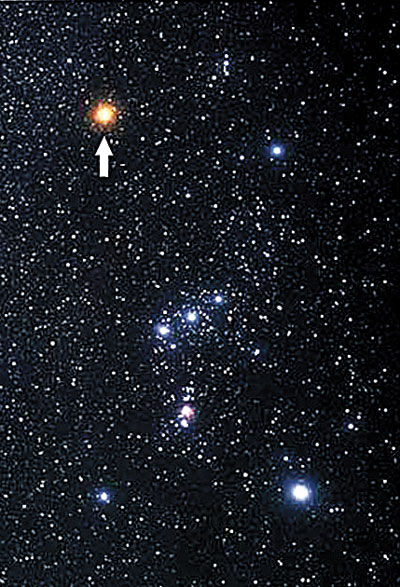
There is a hunter in the winter sky and it is the most prominent winter constellation. It is called Orion the hunter from Greek mythology and it is filled with beautiful celestial objects that will amaze. But the first object to see is a super-duper giant star “Betelgeuse.” It can be found by walking outside around 10:00 p.m. in south Texas and looking straight up and toward the south. By locating the bright orange star that is the right shoulder of the hunter “ assuming he is facing you” (Betelgeuse) pronounced either “Beetlejuice” or “Bet-el -Jooze” by astronomers.
And as the second brightest star in Orion, it is known as one of the largest, known red Super giant stars. It is believed by astrophysicists to be so big that if it sat where our sun is, its surface would reach to Jupiter engulfing Mercury, Venus, Earth and Mars. Its distance from earth is believed to be approximately 640 light-years.
It is a pulsating variable star that seems brighter and dimmer at different times. It was recorded in 1927 at a mag-1.2 and in 1933 and 42 it was at mag-0.2. This is caused by its surface expanding and contracting and that leaves some physicists to believe it will go Supernova someday. And when it explodes it will be so massive that it will be visible even in the daytime.
What is also amazing is that Betelgeuse may go supernova in our lifetime. And if it does, it exploded 640 years ago, because when you look at this wondrous star you are looking at the light that just reached your pupils, but left the star 640yrs ago. Our planet is not expected to be harmed.
Just a little something to know about that bright orange star hanging over Texas.
The last supernova to be seen with the naked eye was in the constellation Ophiuchus October 17, 1604 by Johannes Kepler in northern Italy. And it was visible in the daytime for over three weeks. It was subsequently named after him “Kepler’s Nova 1604”.
Interested in learning astronomy?
Crossroads Astronomy Club meets every third Monday at 7:00 p.m., Room 223 at the University of Houston at Victoria. Call 361-648-0089 for more information.
